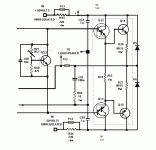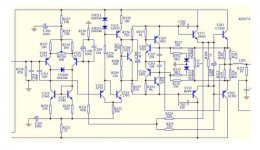Darlington outputs TIP147
Was the load impedance and delivered power spec defined anywhere in or outside of this blog? IMHO it seems to me that the starting point of any amplifier design is the load interface specification which defines the output stage, which defines the drivers, etc. The need to deliver constant Voltage to sub 1 ohm loads at significant power leads to more serious driver problems. The idea that 8 ohms is some kind of load spec is not on the table at all. Amplifiers used in active systems without crossovers between the output and load can have significant simplification when compared to those which do battle with ugly crossover problems. WRT the TIP147, the internal resistive arrangement becomes critical and semiconductor production tolerances are amazing. These generic Darlingtons started life as motor drivers. My vote is to build any Darlington out of discretes and get full control of the resistors and full control of (not limited to 3 terminal) discharge circuit configurations. Lambda did have some very interesting Darlingtons years ago, not sure if they are still available.
Was the load impedance and delivered power spec defined anywhere in or outside of this blog? IMHO it seems to me that the starting point of any amplifier design is the load interface specification which defines the output stage, which defines the drivers, etc. The need to deliver constant Voltage to sub 1 ohm loads at significant power leads to more serious driver problems. The idea that 8 ohms is some kind of load spec is not on the table at all. Amplifiers used in active systems without crossovers between the output and load can have significant simplification when compared to those which do battle with ugly crossover problems. WRT the TIP147, the internal resistive arrangement becomes critical and semiconductor production tolerances are amazing. These generic Darlingtons started life as motor drivers. My vote is to build any Darlington out of discretes and get full control of the resistors and full control of (not limited to 3 terminal) discharge circuit configurations. Lambda did have some very interesting Darlingtons years ago, not sure if they are still available.
Hi,
global feedback and then an EF output stage.
reduces the time delay through the extra stage and reduces the effect of feedback coming in through the output terminal.
That schematic is the first time I've noticed a thyristor wrapped around the IV protection transistor.
Does the thyristor auto turn off when the signal crosses zero volts or does it stay latched on until the cap time constant expires?
Seems to be a way to avoid oscillation during the overload condition.
global feedback and then an EF output stage.
reduces the time delay through the extra stage and reduces the effect of feedback coming in through the output terminal.
That schematic is the first time I've noticed a thyristor wrapped around the IV protection transistor.
Does the thyristor auto turn off when the signal crosses zero volts or does it stay latched on until the cap time constant expires?
Seems to be a way to avoid oscillation during the overload condition.
This is my first post here but I've read a few threads trying to learn about some of the more obscure products I've acquired over the years.
Sorry to resurrect an older thread and perhaps a bit of a hijack, but I found this whilst trying to find out more info on the VA Systems Model 3 power amp. I just acquired one and am very impressed with it.
So far, I've only heard it a bit but it sounds very nice. Impressive build quality to my non-technical/uninformed eyes.
Sorry to resurrect an older thread and perhaps a bit of a hijack, but I found this whilst trying to find out more info on the VA Systems Model 3 power amp. I just acquired one and am very impressed with it.
So far, I've only heard it a bit but it sounds very nice. Impressive build quality to my non-technical/uninformed eyes.
Dalington emitter folloer outputs
Have found in testing that a darlington output can actually have a real problem. The drive transistor can be turned off before the output transistor can be turned off for some reason. Only have seen this with darlington connected stage.
Perhaps one of these bright guys with a simulator can explain the exact reason for this. Darlington has lead to lots of class B crossover distortion and other stability problems. Use the same amp with drivers and outputs where the drivers are just connected to the base of the output transistors and the problems vanish. Has something to do with the darlington configuration.
Have found in testing that a darlington output can actually have a real problem. The drive transistor can be turned off before the output transistor can be turned off for some reason. Only have seen this with darlington connected stage.
Perhaps one of these bright guys with a simulator can explain the exact reason for this. Darlington has lead to lots of class B crossover distortion and other stability problems. Use the same amp with drivers and outputs where the drivers are just connected to the base of the output transistors and the problems vanish. Has something to do with the darlington configuration.
in my view the integrated darlington was produced to reduce assembly costs and for no other reason.Have found in testing that a darlington output can actually have a real problem. .......... Has something to do with the darlington configuration.
It is a bad implementation of two transistors.
Have found in testing that a darlington output can actually have a real problem. The drive transistor can be turned off before the output transistor can be turned off for some reason. Only have seen this with darlington connected stage.
Perhaps one of these bright guys with a simulator can explain the exact reason for this. Darlington has lead to lots of class B crossover distortion and other stability problems. Use the same amp with drivers and outputs where the drivers are just connected to the base of the output transistors and the problems vanish. Has something to do with the darlington configuration.
that's actually very well documented...the miller capacitance of the output devices is the culprit. since in a darlington the beta is beta(Q1)*beta(Q2), the miller capacitance is much larger. that's why "darlington" output stages have low resistances and speed-up capacitors between the emitters of the driver transistors in most modern amps.
Last edited:
Debating qualities (or lack of) of darlingtons is somewhat pointless
when using old trannies as TIP147 and their likes as exemples.
Would someone build an amp using TIP29C/30C as drivers and TIP33C/34C
as power devices that he would be left equally deluded when compared to
modern devices.
There is excellent darlingtons , provided they are audio oriented.
As good exemples , the Sanken MP1620/MN2488.
when using old trannies as TIP147 and their likes as exemples.
Would someone build an amp using TIP29C/30C as drivers and TIP33C/34C
as power devices that he would be left equally deluded when compared to
modern devices.
There is excellent darlingtons , provided they are audio oriented.
As good exemples , the Sanken MP1620/MN2488.
I prefer a triple T Wahab. For bipolar output stages, I think this is a the best approach. Have you done any amps with darlington o/p stages?
I have done many using the devices i mentionned.
They display very good caracteristics.
How is the sound?..Well, as good as the one provided
by the more classic toshiba 2SA1837/2SC4793 + 2SA1943/2SC5200.
I tested this latter combination recently and it didn t t make any difference.
I don t know if the MP1620/MN2488 are still manufactured.
The 2SB1570/2SD2401 ,among others, also from Sanken,
are good replacement with a slightly increased Ic max.
Anyway, it seems that people are testing old darlingtons
of the 3055 era and then take their measurements as granted
for the whole family.
Attachments
the MP1620/MN2488 devices are still currently used in Sony amps, so yes they are still being made. beware of fakes, though. there are a lot of fakes of all Sanken output devices floating around in the supply chain, and the MP1620/MN2488 devices are among the most commonly counterfeited.
I tried to compare the Bryston OPS and a double EF with spice, and got consistently lower THD with the Bryston (10 to 40%) I will admit that it wasnt easy keeping every variable accounted for so it would be nice to hear from anyone else who has tried this. I think the advantage of the bryston OPS is that your not switching from NPN to PNP devices and their different characteristics but a pair of each sharing the output current. Dont know how much that matters or if modern devices null that advantage. The disadvantage seems to be stability. The sims showed better phase margin with the EF.
Another caveat is that the Bryston stage has a diffrent distortion pattern, odd harmonics are higher than with a EF.
Lazycat a member here uses the Bryston stage but uses a mosfet as the the driver, clais very good sonics, you may want to read up a little on that topic if you interested in this bryston outputstage.
Ive tried tried it as well as the standard and still prefer the Locanthi triple stage which gives better performance than either the Bryston or the EF and has a nicer distortion pattern too.
Unclejed the MP1620/MN2488 I think have been discontinued or they were made for sony, there have been some reliabilty problems with those and the SAP named devices, new devices were introduced to replace them.
Not only Sony that uses them but some high end manufacturers too such as Arcam.
Lazycat a member here uses the Bryston stage but uses a mosfet as the the driver, clais very good sonics, you may want to read up a little on that topic if you interested in this bryston outputstage.
Ive tried tried it as well as the standard and still prefer the Locanthi triple stage which gives better performance than either the Bryston or the EF and has a nicer distortion pattern too.
Unclejed the MP1620/MN2488 I think have been discontinued or they were made for sony, there have been some reliabilty problems with those and the SAP named devices, new devices were introduced to replace them.
Not only Sony that uses them but some high end manufacturers too such as Arcam.
Right on the target, unclejed...
I did first find them in a sony four channels amp ten years ago..
The amp was badly damaged , with the DSP blown among other components.
But the four pairs of output devices were still safe, and it s almost all that was
saved from this amp, so i cannibalized them with great pleasure....
I did first find them in a sony four channels amp ten years ago..
The amp was badly damaged , with the DSP blown among other components.
But the four pairs of output devices were still safe, and it s almost all that was
saved from this amp, so i cannibalized them with great pleasure....
- Status
- This old topic is closed. If you want to reopen this topic, contact a moderator using the "Report Post" button.
- Home
- Amplifiers
- Solid State
- Power Amplifier Output Topologies

